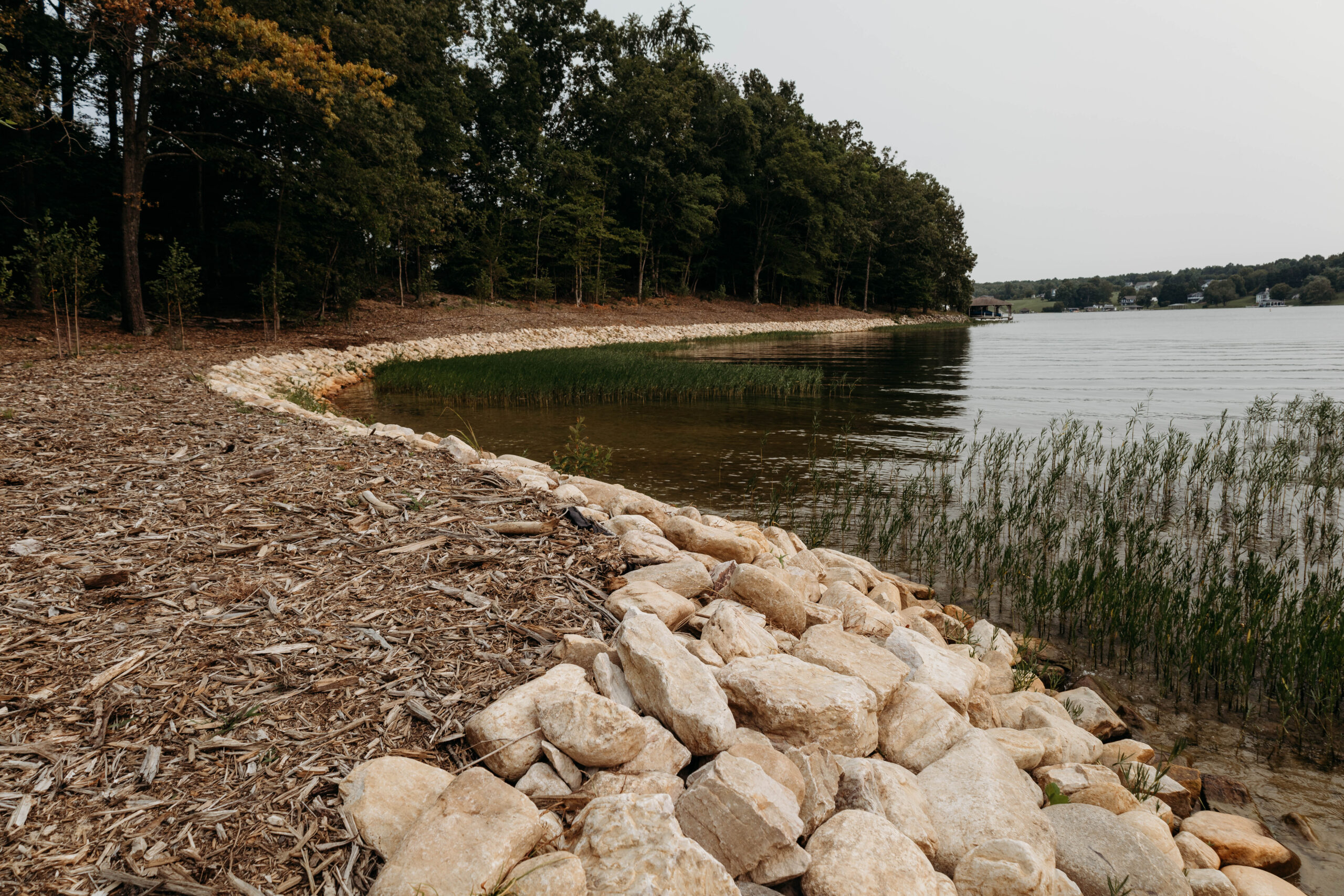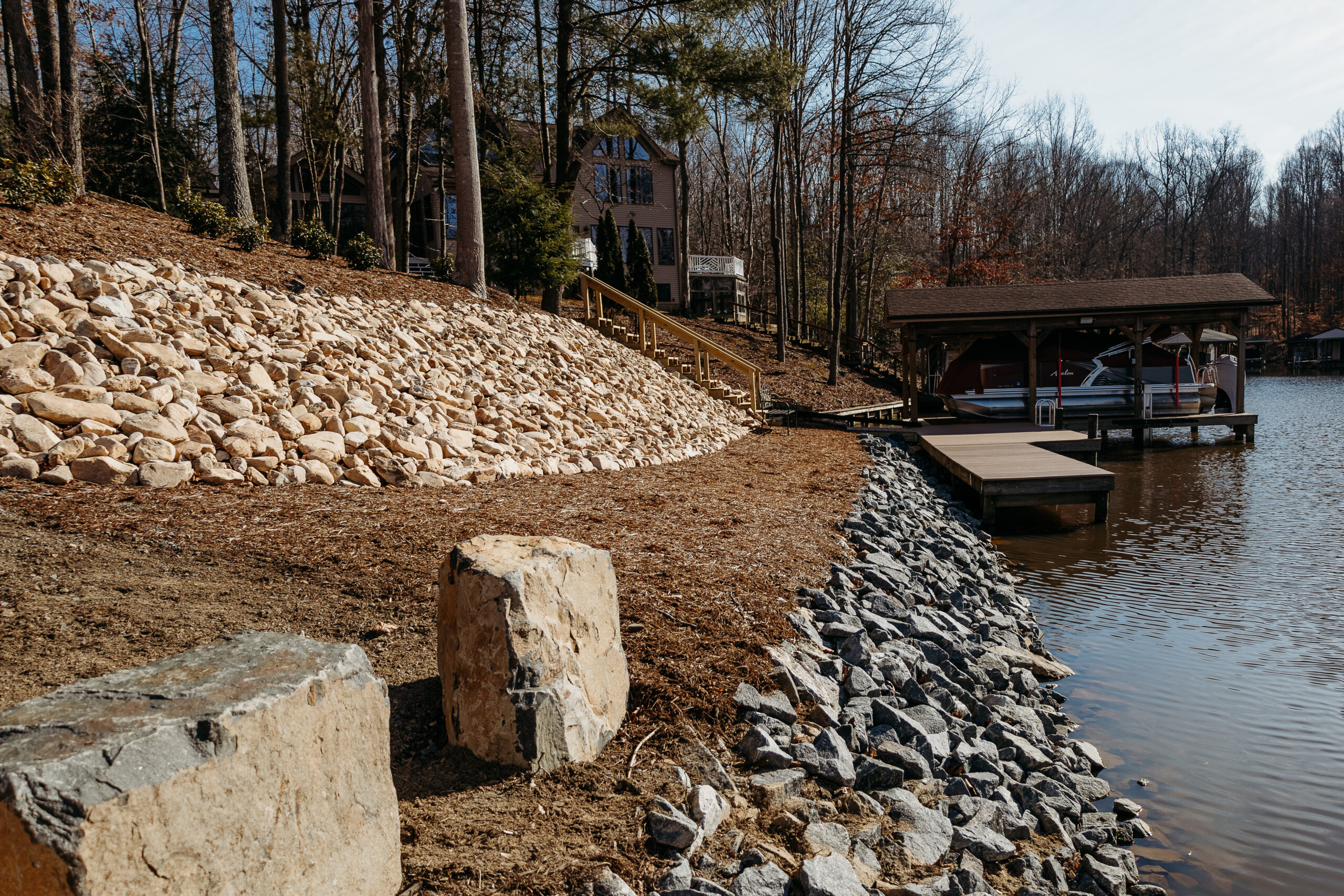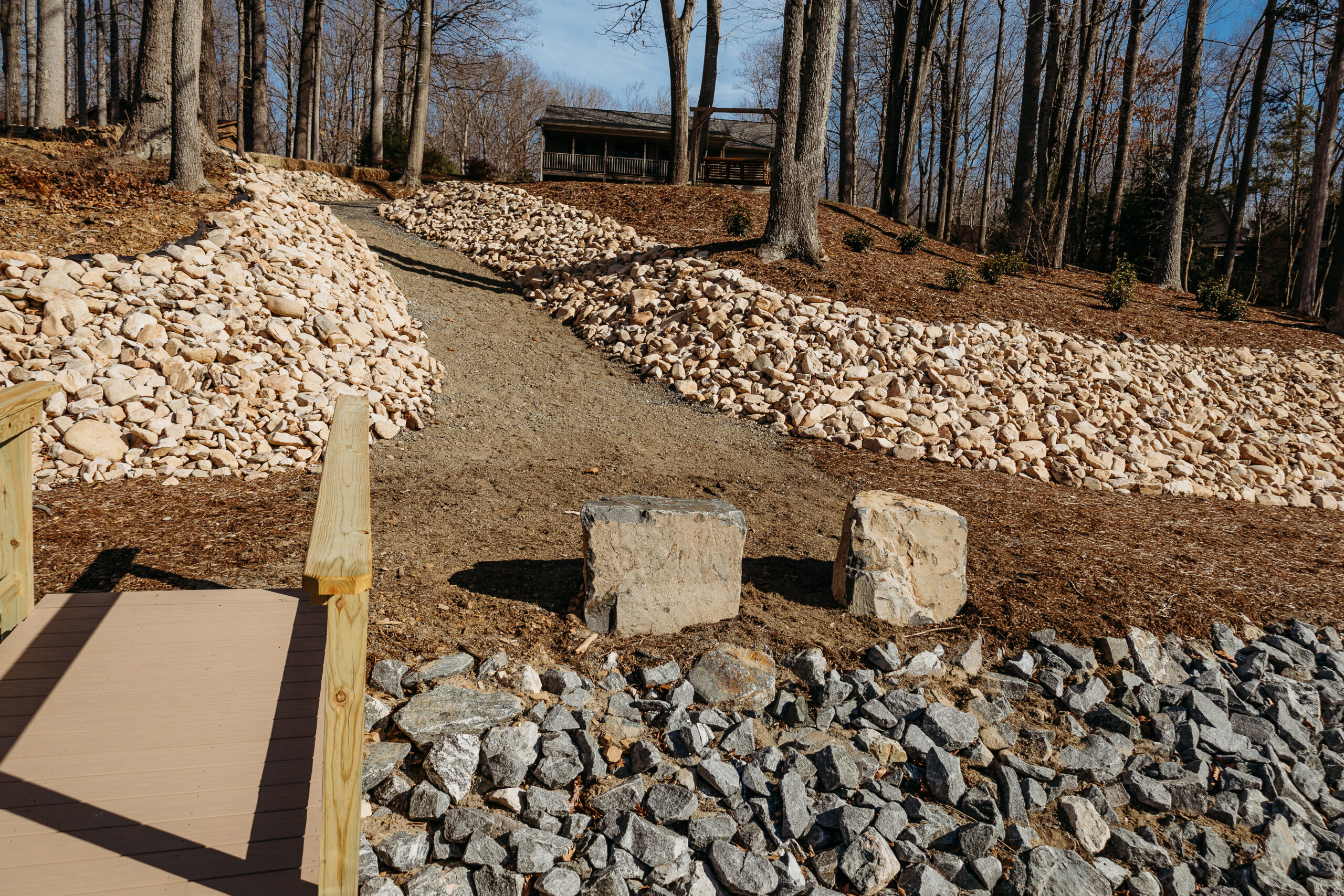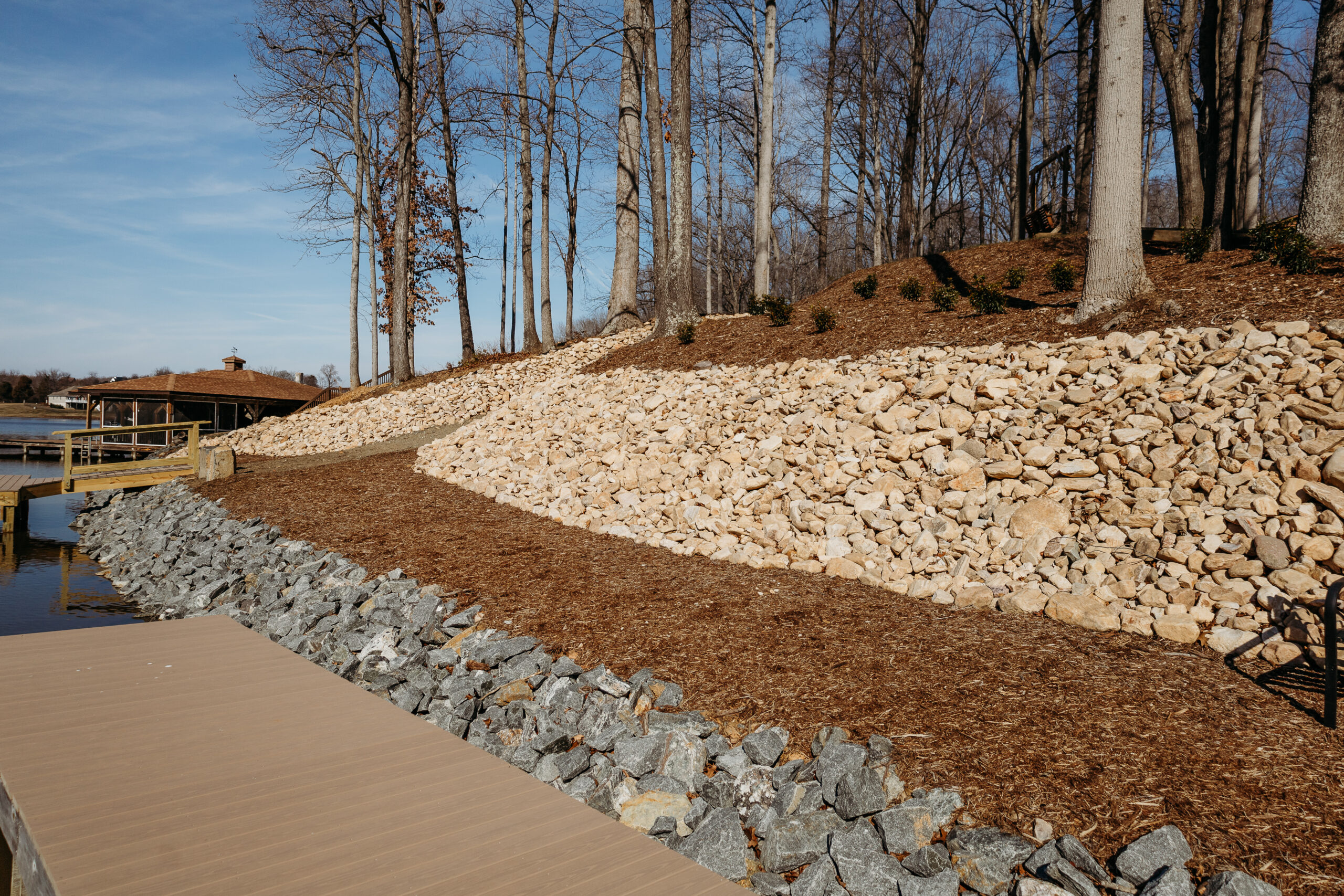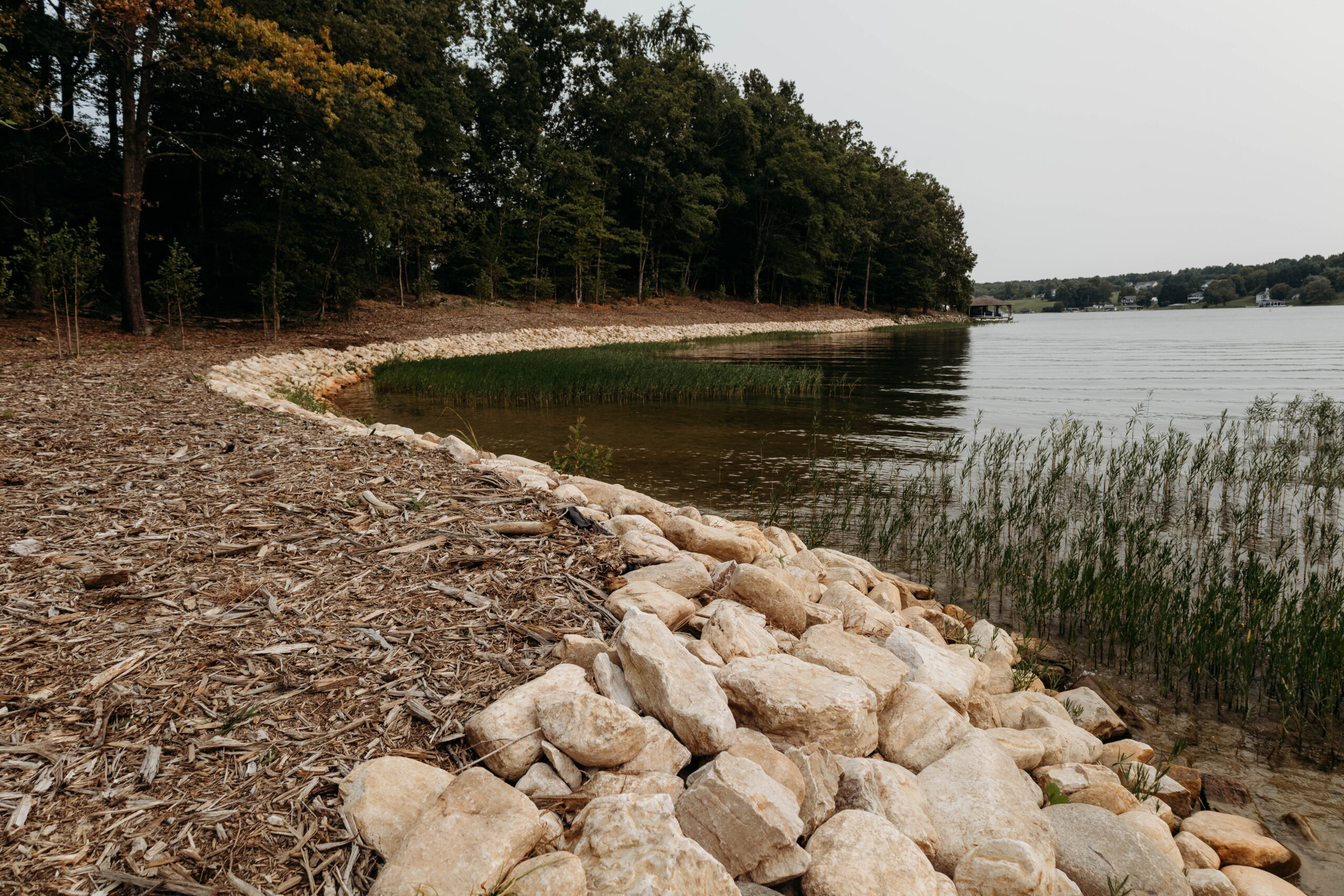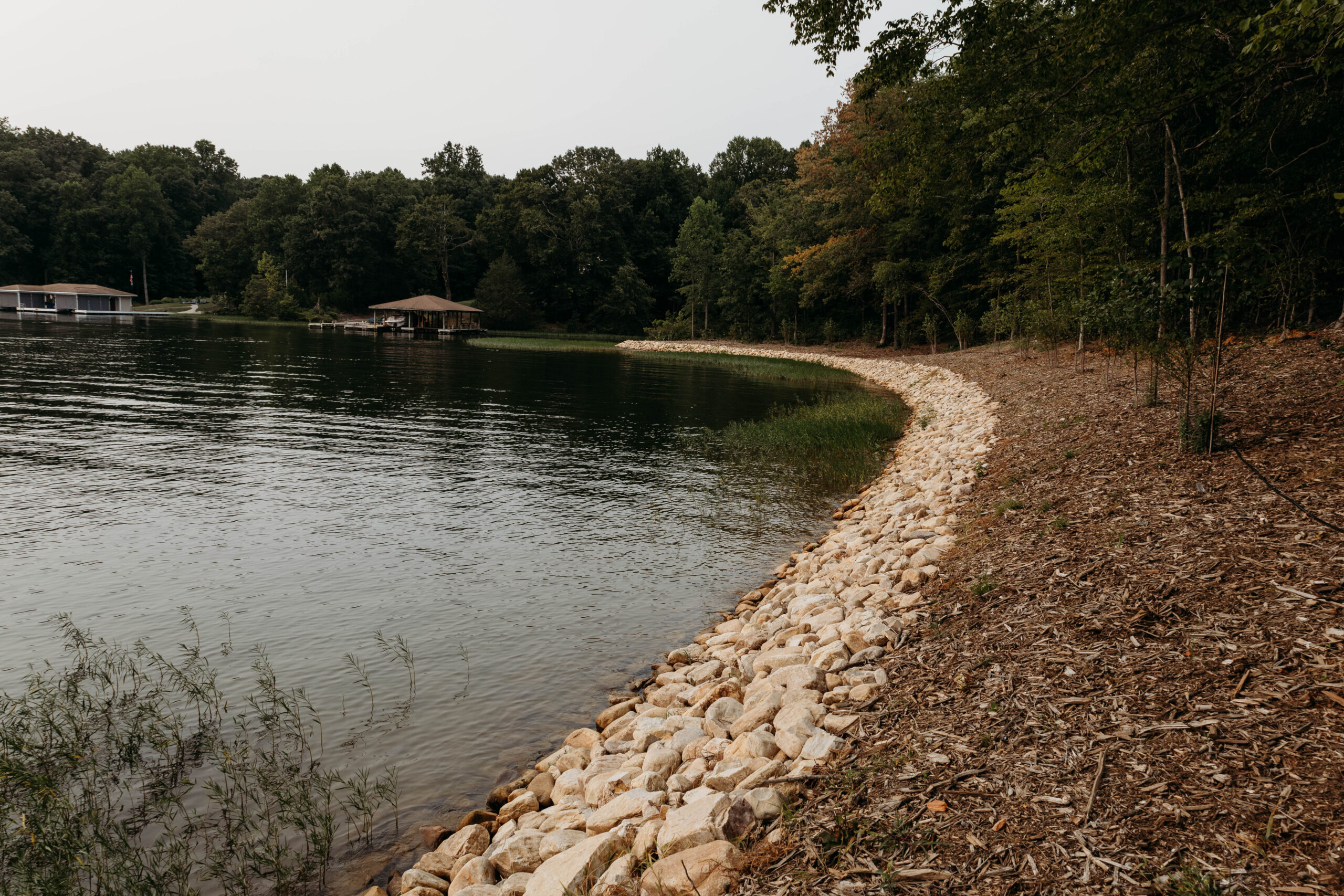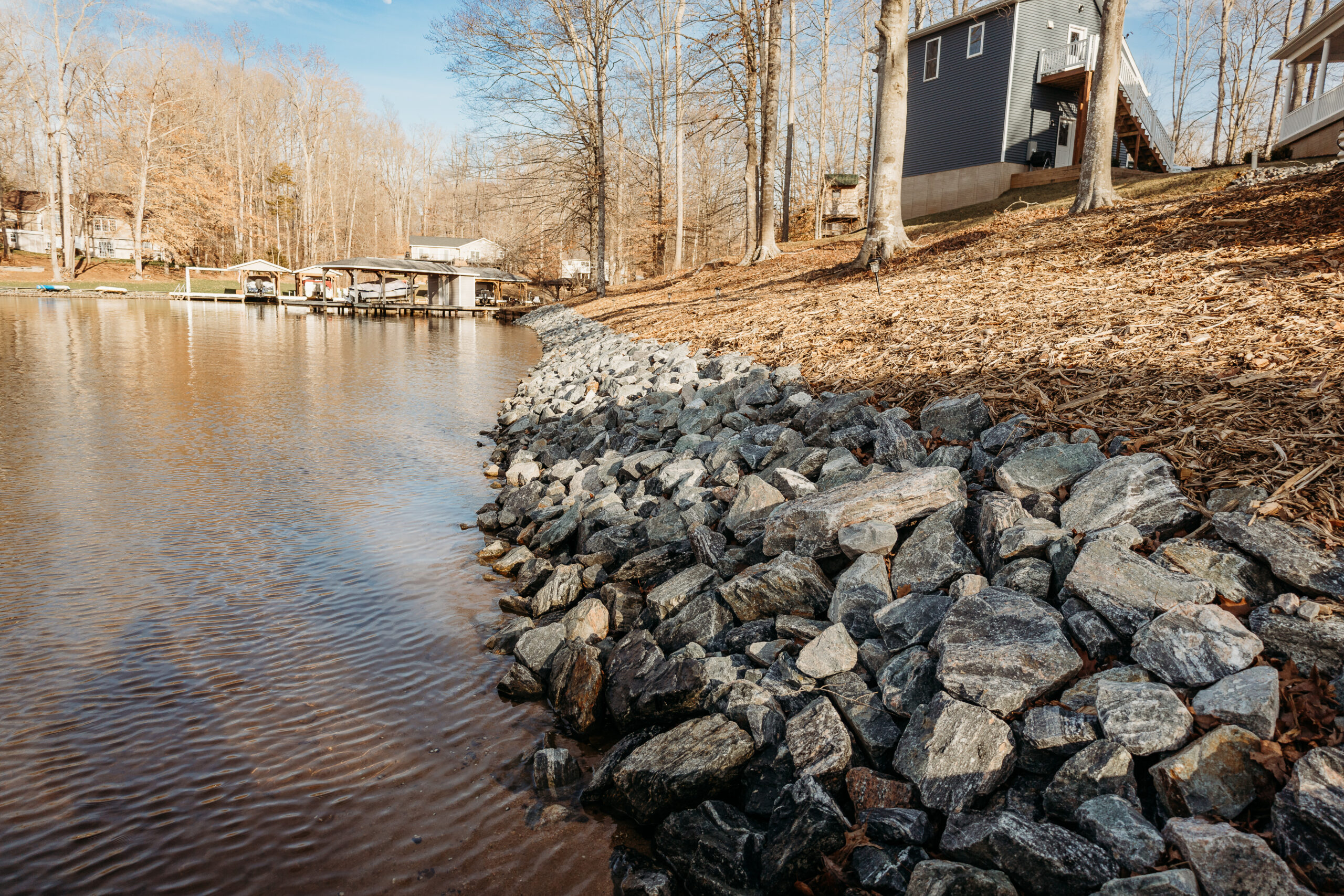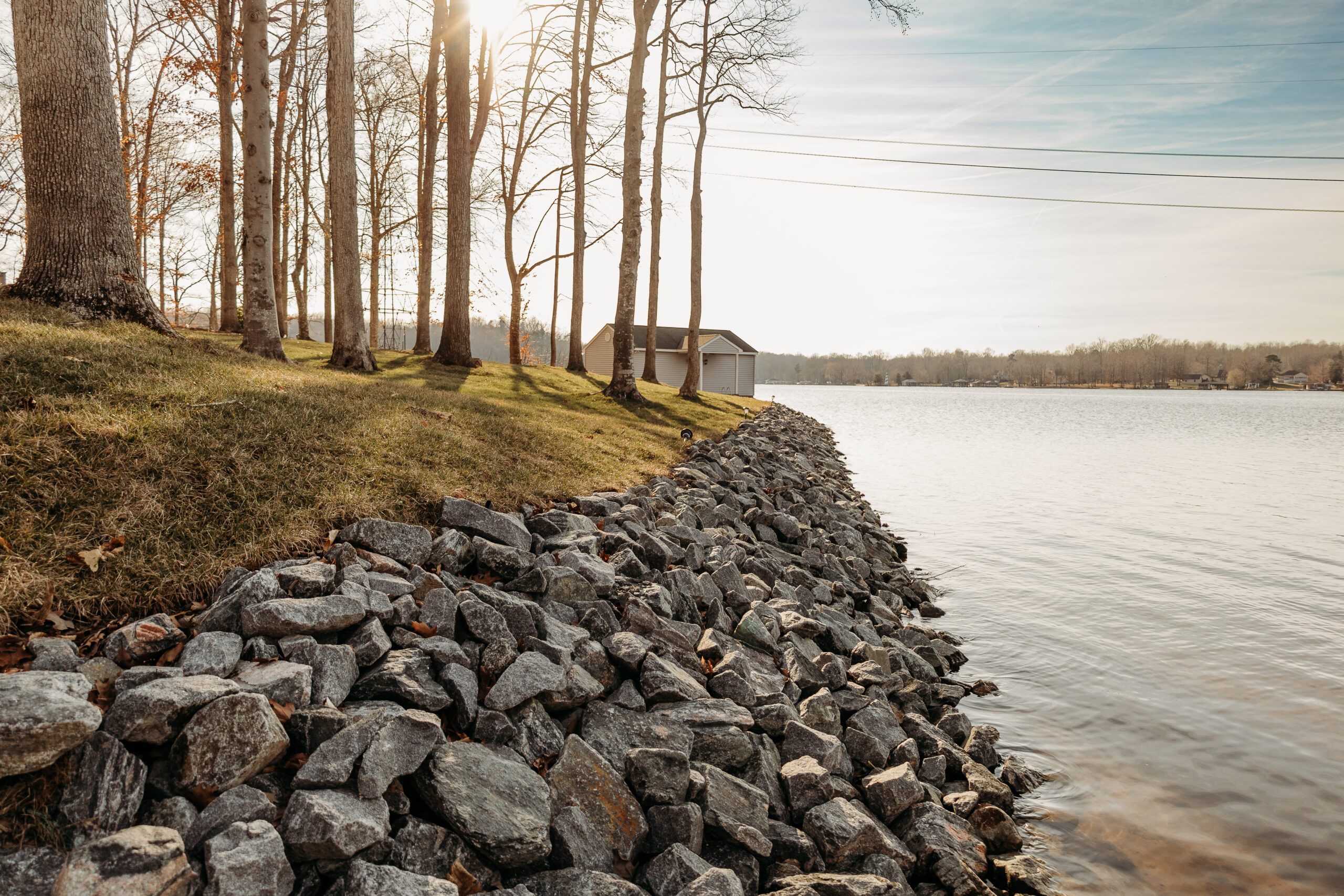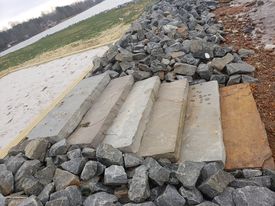Riprap Solutions
Riprap is the most economical & long lasting solution to prevent erosion and slow vegetative growth on your shoreline. This is the most common form of erosion control at Lake Anna. We have two options of stone that we can use;

Grey Granite
- Granite; this stone has sharper edges, which lock together better and is blue and gray in color. Granite has better availability. This stone is sourced in most of the quarries in the area.
Mountain Stone Tan
- Mountain stone; this stone has more rounded edges and is tan and brown in color. This blends great with a natural mulch background. This stone is sourced in Shenandoah
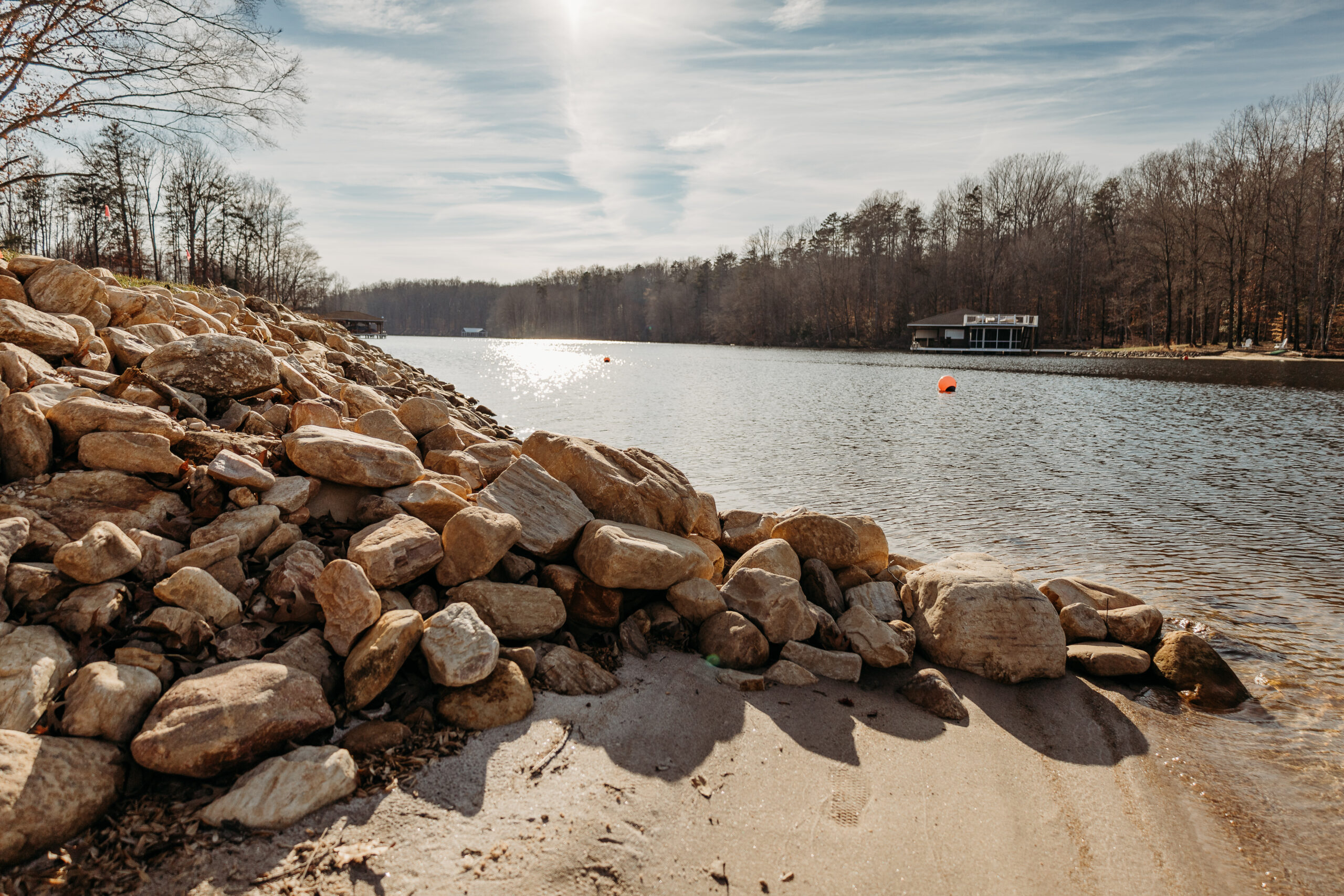
Riprap is a great option for steeper shorelines in the Lake Anna area. When installing riprap on steeper shorelines, we have to create and access path for our machines to shape the shoreline, install fabric, and then the stone. This usually results in a shelf or flat area that is around 10 feet wide. This can be kept after the project, however, there will need to be a solution to retain the upper side of the hill but this leads to a very valuable area close to the water that is excellent for sitting, lawn games, or even fishing!
We completed this project in The Waters community in March 2017. The homeowner stabilized the upper side using fabric and ground cover. The materials used for this project were granite riprap and gabion blend. For boaters seeking it out, this property is located on the private side of Lake Anna. To find it, enter Beaver Creek towards the Seclusion Shores community, and you’ll spot it on the right-hand side
We completed this project in the Belmont area near The Cove restaurant in June 2019. For those navigating by boat, departing from The Cove, head towards Terry’s Run and follow the first cove you encounter. Previously, the only access to the water was via a set of steps leading to the dock, which restricted activities near the shoreline. Our project involved creating a new access path designed for both walking and accommodating golf carts. This enhancement allows easier transport of heavier items such as coolers or gasoline to the dock area. Furthermore, it significantly expanded their view and mitigated further erosion of their lakefront property.
This shoreline project was completed in September 2023, using a variety of materials. Gray granite stone was chosen for the shoreline itself, providing durability and aesthetic appeal. Above the shoreline, a layer of single shred mulch was installed, offering a low-maintenance solution that helps to secure the soil. Further up the hillside, mountain stone was used to stabilize the terrain. Additionally, two strategically placed boulders were installed at the entrance ramp to this area.
Local Landscapers obtained full permitting from Dominion and Spotsylvania County and is located in the Belmont area near The Cove, adjacent to the project shown above. For boaters, departing from The Cove, simply head towards Terry’s Run and navigate into the first cove you encounter.
This project is located northeast of Rose Valley Island and involved stabilizing approximately 375 linear feet of shoreline in April 2023. We used mountain stone along with single-shred mulch spread behind it to stabilize the soil. Additionally, we planted multiple River Birches immediately behind the shoreline. Before our intervention, the shoreline was continually receding. The goal of this project was to preserve the land and prevent further erosion. Completed in Spotsylvania County, Local Landscapers obtained the necessary permits from the county and Dominion.
This shoreline project was completed in November 2023 using gray granite stone. Alongside the shoreline work, we undertook a major grading project on the right side, removing multiple stumps and debris to prepare the area for a lawn. We installed nearly 100 yards of screened topsoil before laying approximately 8,000 square feet of sod behind the shoreline. On the left side, we spread single-shred mulch above the riprap to hold the soil and create a space for future shrub planting.
Local landscapers obtained full permitting from Dominion and Louisa County. The project is located on the private side, on the point between the two Cuckoo’s Nest common areas.
Riprap Project Summary
**Location:** Millpond Creek, Private side of Lake Anna (near the big blue boat houses for the Mill Run community, just past the 652 bridge from Dyke 2)
**Original Installation:**
– Approximately 7 years old
– Showing signs of deterioration: Waves breaching, fabric tearing, erosion
**Steps Taken:**
1. **Shoreline Elevation:**
– Brought in 13 loads of fill to raise the shoreline level
– Aim: Easier maintenance, preventing wave overtopping
2. **Fabric Upgrade:**
– Replaced with a heavy-duty grade fabric
– Aim: Enhance durability and longevity
3. **Stone Addition:**
– Reused all existing riprap stone
– Added 34 tons of mountain stone
– Aim: Replenish and stabilize the shoreline
4. **Topsoil Addition:**
– Brought in two loads of topsoil
– Aim: Ensure optimal conditions for grass growth
**Outcome:**
– Restored and strengthened shoreline
– Enhanced resilience for years to come
This detailed approach should greatly enhance the stability and longevity of this shoreline at Lake Anna.
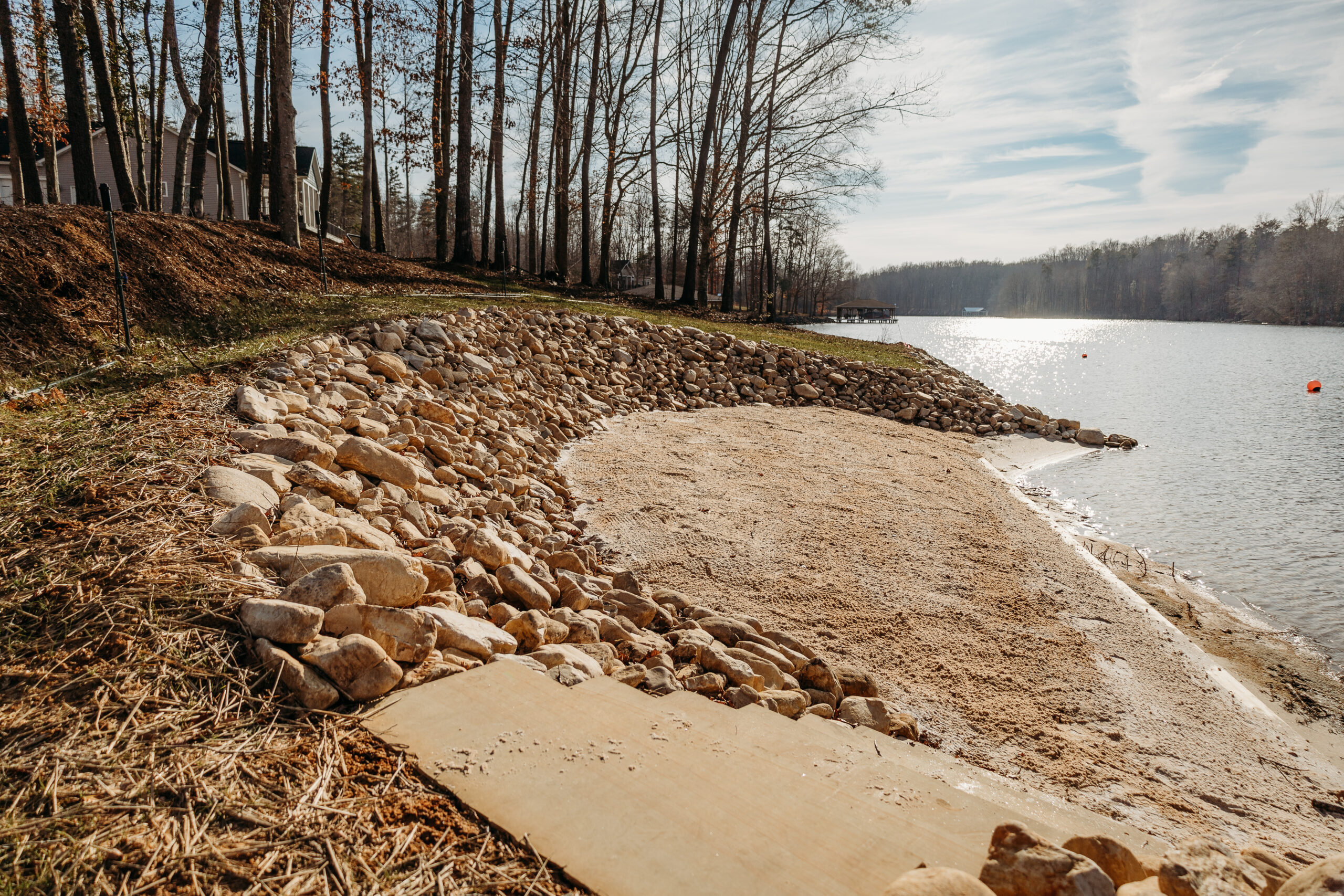
This is a beach we installed big enough to park an airplane in (literally). Our client has a water plane that he flies down to visit his Lake Anna property. Rather than building a hangar, he decided to build a beach that would double as a parking spot for his airplane! We included a set of steps for easy access in and out of the beach. The riprap is extended on both edges to create a sort of “jetty” affect to help reduce the sand erosion. Those have ended up naturally collecting some more sand.
Below are before and after photos of a project where we removed really old docks that wrapped around the point of the property. We also removed a failing retaining wall and recreated the shoreline with a nice riprap finish.
Riprap Pricing Guide
You may be wondering, “What will this cost?” The answer is: it depends. Several factors influence the pricing of a riprap project, including the type of stone, site access, existing shoreline conditions, finished height of the shoreline, and overall length of the shoreline.
**Type of Stone:**
While both types of stone are priced similarly, granite is generally more affordable.
**Site Access:**
Easy access to the project area can significantly reduce costs. If a dump truck can get close to dump to the shoreline, it saves time and money on installation. Conversely, the presence of trees or debris that need removal can increase costs.
**Shoreline Conditions:**
The finished height of the shoreline plays a crucial role in pricing. Taller shorelines require more materials and time to construct, raising the overall cost.
**Shoreline Length:**
The overall length of the shoreline also affects pricing. Longer shorelines often benefit from better per-foot pricing, while shorter shorelines typically cost more per linear foot.
**Pricing Examples:**
– **Optimal Conditions:** A shoreline that is short in height but lengthy, with good access and minimal removal or fill requirements, can start as low as $75.00 per linear foot.
– **Challenging Conditions:** A steep, tall shoreline with limited access, dense wooded areas requiring significant fill dirt and debris removal, can cost $135.00 or more per linear foot.
Each project is unique, and we tailor our solutions to fit your specific needs and conditions. Contact us for a detailed quote and to discuss how we can best serve your shoreline stabilization needs.
We can also install a set of steps into your riprap shoreline to provide access to you or your pets getting in and out of the water easier.
This is a beach project installed using boulders to encase the beach and a set of steps created with large natural stone slabs. These slabs in front act as a set of steps and also help retain the sand. The shoreline on both sides of the beach has riprap installed with the brown and tan mountain stone.

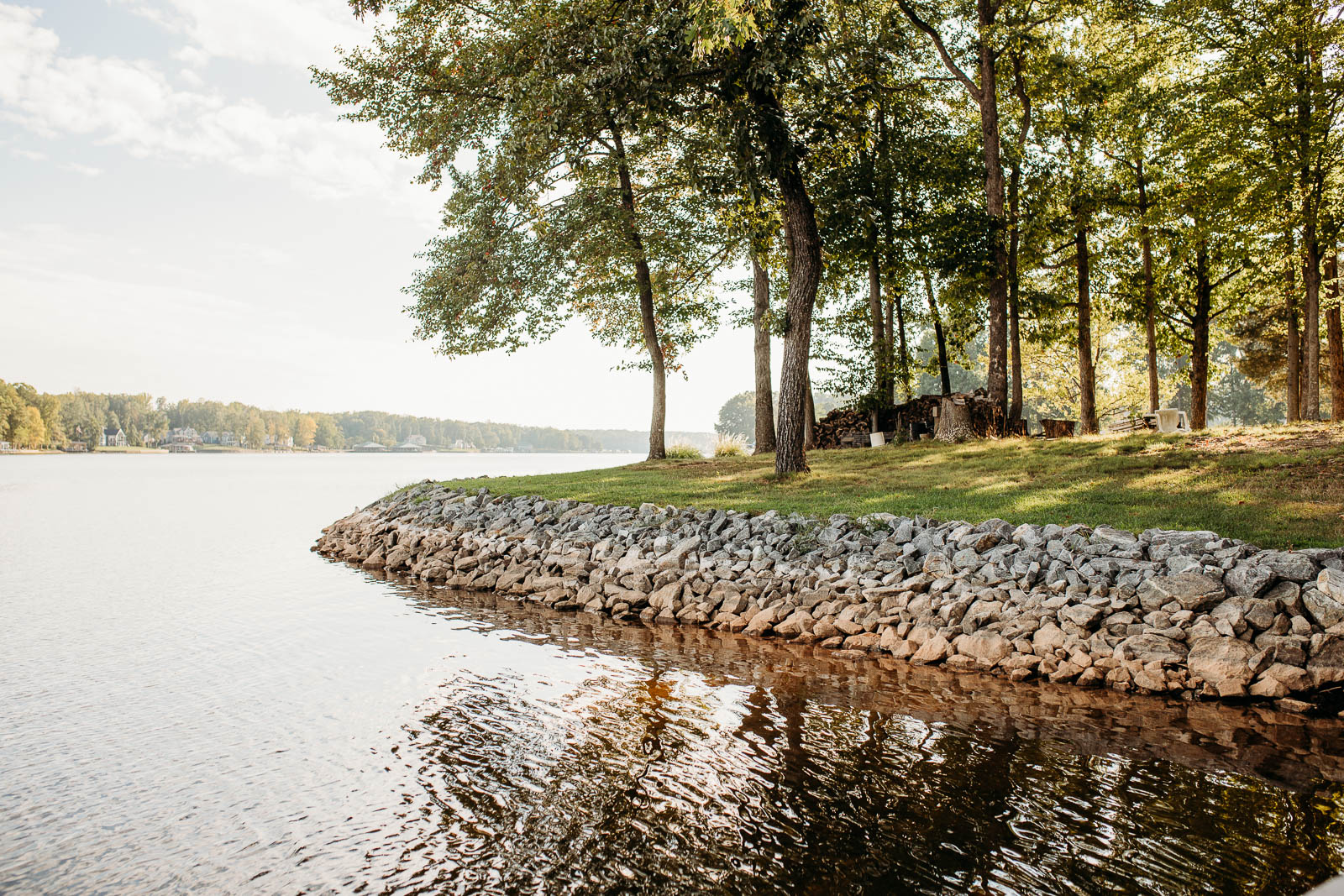
In February 2023, we completed this riprap project on the private side of Lake Anna. We elevated the shoreline and installed a blend of granite riprap and gabions. The areas behind the riprap were regraded, seeded, and strawed to establish a lush lawn.
The problem with the original riprap was the fabric was tearing, areas were eroding and waves were crashing over the top of the stone eroding behind it making it tough to maintain the grass closer to the shoreline.
Our goal was to achieve a consistent & even finished height throughout the shoreline. We also aim for a smooth finish on the riprap, which we accomplished using our equipment to pack it in during installation. This helps with the finished look, but also strengthens it by locking the stones together. This project is located in mill pond creek at the 652 bridge across the water from Lighthouse Point.
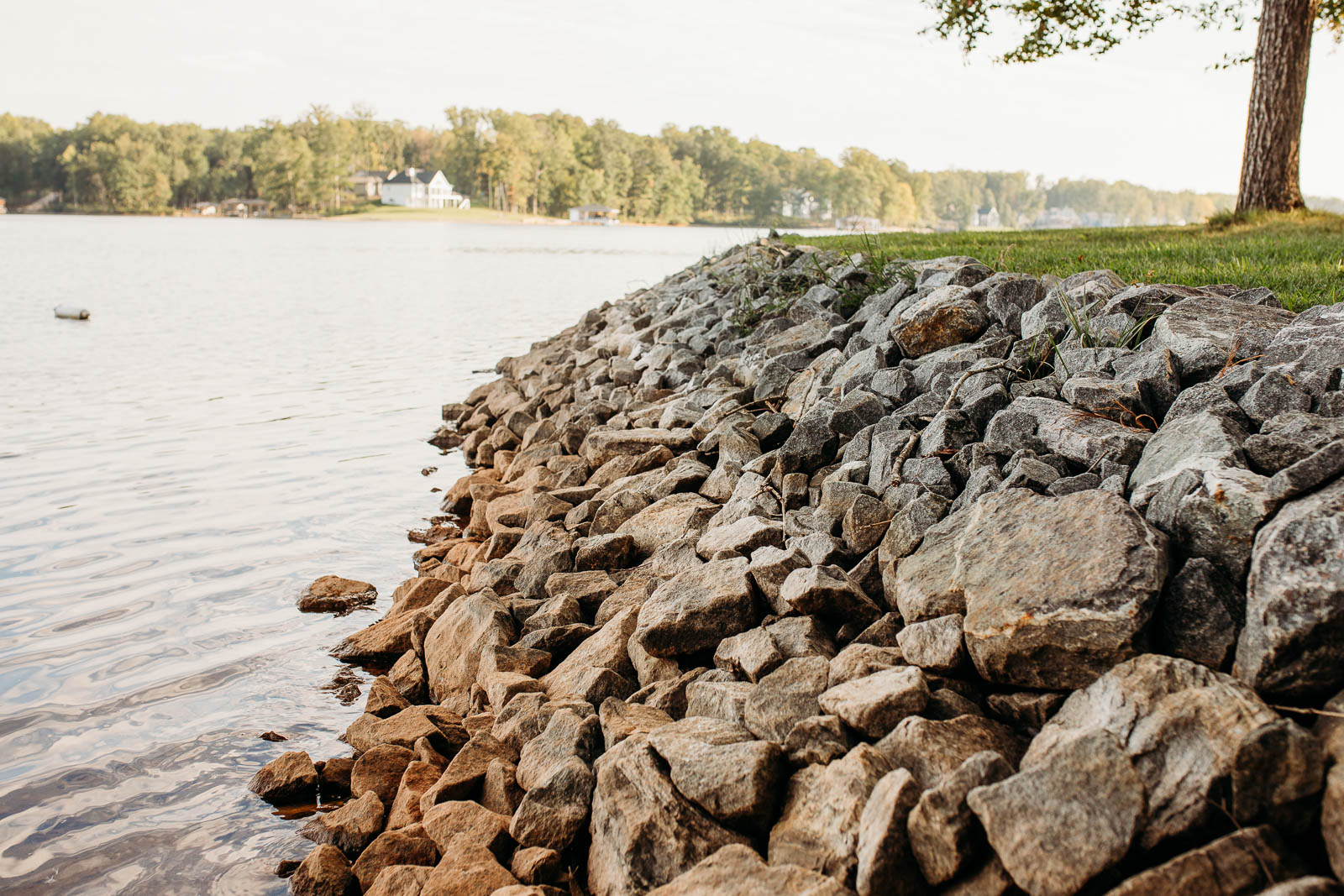

Do snakes like riprap?
Yes, you may see more snakes on a riprap shoreline compared to a wall or boulder shoreline. However, the number of snakes you encounter can vary. For example, the last time I observed a snake on a riprap shoreline, I saw only one, which quickly scurried away along a 1,500-foot stretch. On a typical day, you might not see any snakes at all.
How does riprap prevent the shoreline from eroding?
Although it might appear that the rocks are what stabilize the shoreline, it is actually the geotextile fabric that holds the sediment in place. The riprap stones serve to anchor the fabric. This is why using high-quality geotextile fabric is crucial.
What is geotextile fabric?
Geotextile fabric is a vital component used in riprap shorelines to enhance their stability and effectiveness in preventing erosion. In riprap applications, it is typically made of synthetic materials like polypropylene or polyester. Geotextile fabric plays a crucial role in ensuring the effectiveness and longevity of riprap shorelines by stabilizing soil, preventing erosion, and supporting the structural integrity of the shoreline.
I have riprap, but he needs repair, what should I expect?
Riprap repair is a straightforward project for us. It requires a Dominion permit and, if applicable, a simple Spotsylvania permit. If the geotextile fabric is in good condition and extends to the top of the shoreline (with waves not crashing over), topping the area with more rock may be a suitable repair. However, if the fabric is sagging, torn, or missing, we recommend a full replacement. We can reuse the existing stones on the shoreline and bring in additional rock as needed.
How long does riprap last?
The longevity of a riprap shoreline can vary significantly depending on several factors, but it typically lasts anywhere from 20 to 75 years.
- Short-Term: Poorly installed or maintained riprap may last only 8–20 years, especially in challenging environments.
- Average Lifespan: With proper materials and maintenance, most riprap shorelines can last 30–50 years.
- Long-Term: In optimal conditions with excellent materials and care, a riprap shoreline can last up to 75 years or more.
What kind of maintenance does riprap have?
- Regular Inspections: Periodic inspections can help identify and address issues early, such as displaced stones or damaged fabric.
- Repairs and Upkeep: Timely repairs, such as adding more rock or replacing damaged fabric, can prolong the shoreline’s lifespan.
- Vegetation Control: Vegetation can help stabilize the shoreline, but it’s important to keep it manageable to prevent damage. Avoid allowing plants to grow into the fabric and potentially tear it. For instance, if a tree grows too large and tips over, it could expose the root ball and create a large gap in the shoreline.

